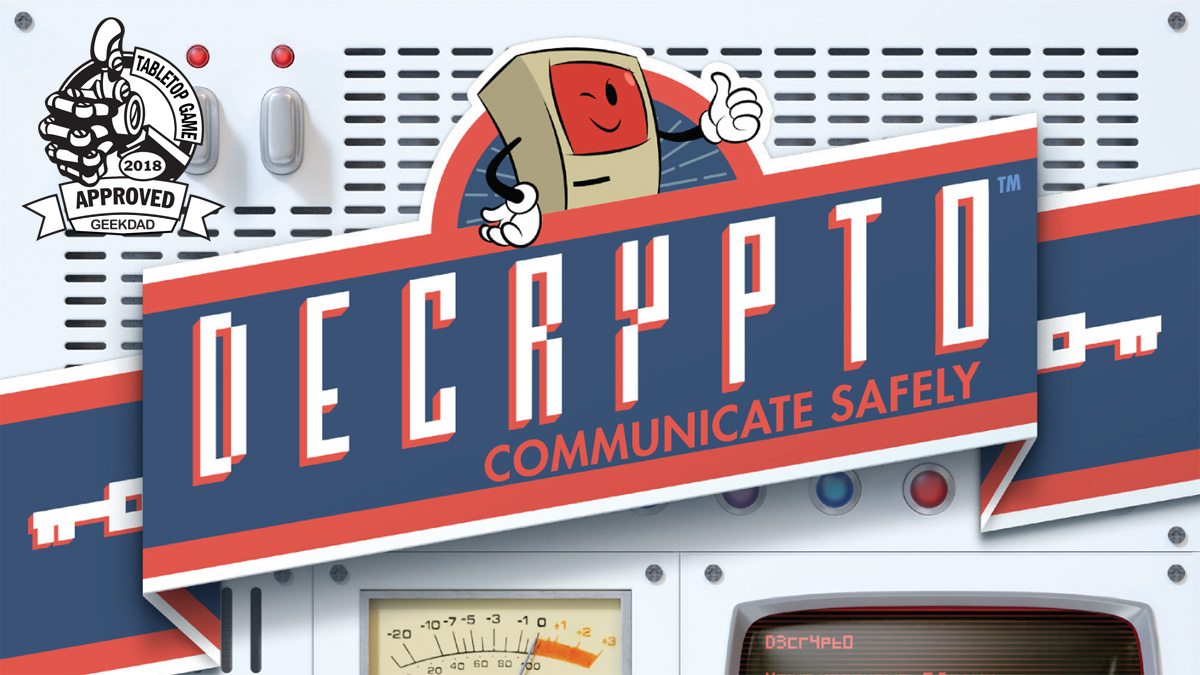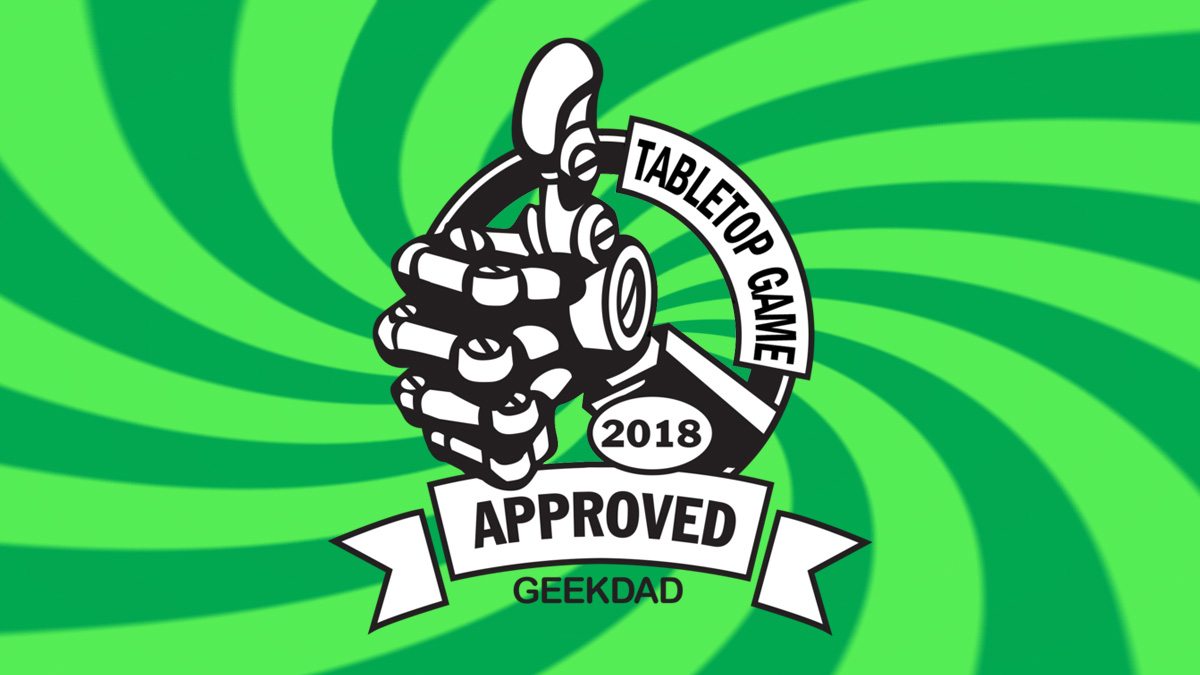Transmit coded messages to your teammates using your code words… but be sneaky, because your rivals are trying to intercept your messages!
What Is Decrypto?
Decrypto is a game for 3 to 8 players, ages 12 and up, and takes about 30 minutes to play. It will retail for $19.99; it will be released in April, but GAMA retailers may sign up with Iello Games to receive it earlier. You can also preorder it now from the Iello Games website. (Decrypto was originally published in Quebec by Scorpion Masque and is distributed in English in various markets by Iello Games.) The game can be played with younger players, but the clue-giving aspect may be a little trickier for them to grasp. Although you can play with 3 players, the full ruleset is for 4 or more players.
Decrypto is GeekDad Approved!

Decrypto Components
Here’s what’s included:
- 2 Screens
- 48 Code cards (24 white, 24 black)
- 110 Keyword cards
- 4 Interception tokens
- 4 Miscommunication tokens
- 1 30-second Sand TImer
- 50 Note Sheets
The game has a retro-tech aesthetic that’s very fun: the code cards look like 5.25″ floppy disks (kids, ask your parents) and there’s a little anthropomorphic computer mascot that looks like the original Macintosh. The screens and keyword cards use red filters to “decipher” the jumbled text, kind of like those stat charts on the packaging of old Transformers (kids, ask your parents again).
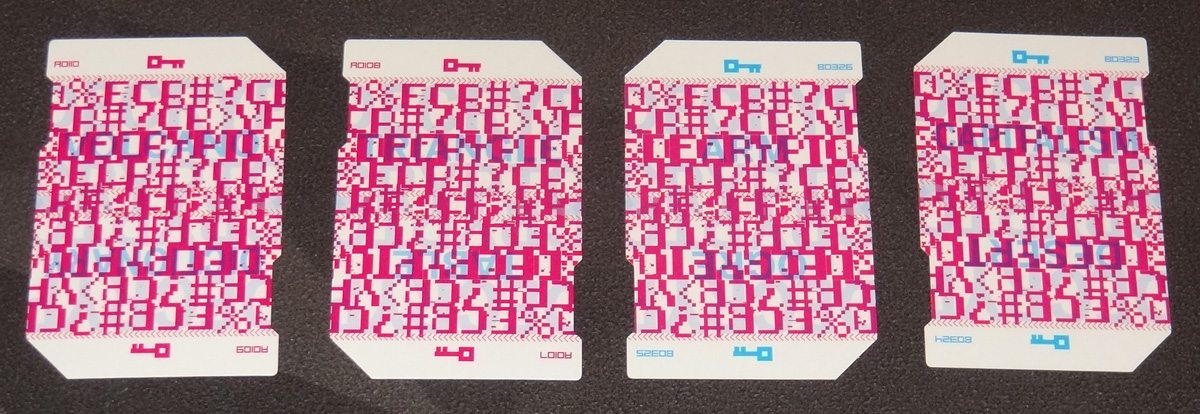
The components themselves are fairly nice. Each keyword card has four words on it: top and bottom, double-sided. They’re also marked with blue keys on one side and red keys on the other, in case you want to go through the whole deck on one side before flipping over to the other side, to reduce overlaps between games.

The screens are made to look like four computer screens: inserting the keyword cards into the top of the screen reveals the keyword on the screen, which has a red filter. You can read a keyword card without the red filter if you look closely, but it’s not meant to be uncrackable–it’s meant to prevent players from seeing another team’s keywords accidentally. Each screen has two feet that fit into the notches so it stands up; I found that some of the feet fit a little loosely and were liable to fall off if you picked up the screen.
I haven’t looked through the entire stack of keyword cards (particularly because I’d need a red screen to do that easily) but we did spot at least one typo recently: “Labyrinth” was printed as “Labtrinth.” I won’t be able to say how common typos are until I’ve played a lot more, though.
The one gripe I’ve heard about the illustrations on the screen is that the three “switches” (part of the visual design) below each screen are meaningless. In particular, the switches under the second screen and the fourth screen are in the same positions–they could have been made to be binary numbers, or something, and it’s not clear why there are two screens with the same switches. Ah, well.
The whole thing comes in a medium box, about the same size as the box for Codenames. It could have been even a little smaller, but the box footprint is limited somewhat by the notepads. Speaking of which, you’ll need to provide your own writing utensils, one per team.
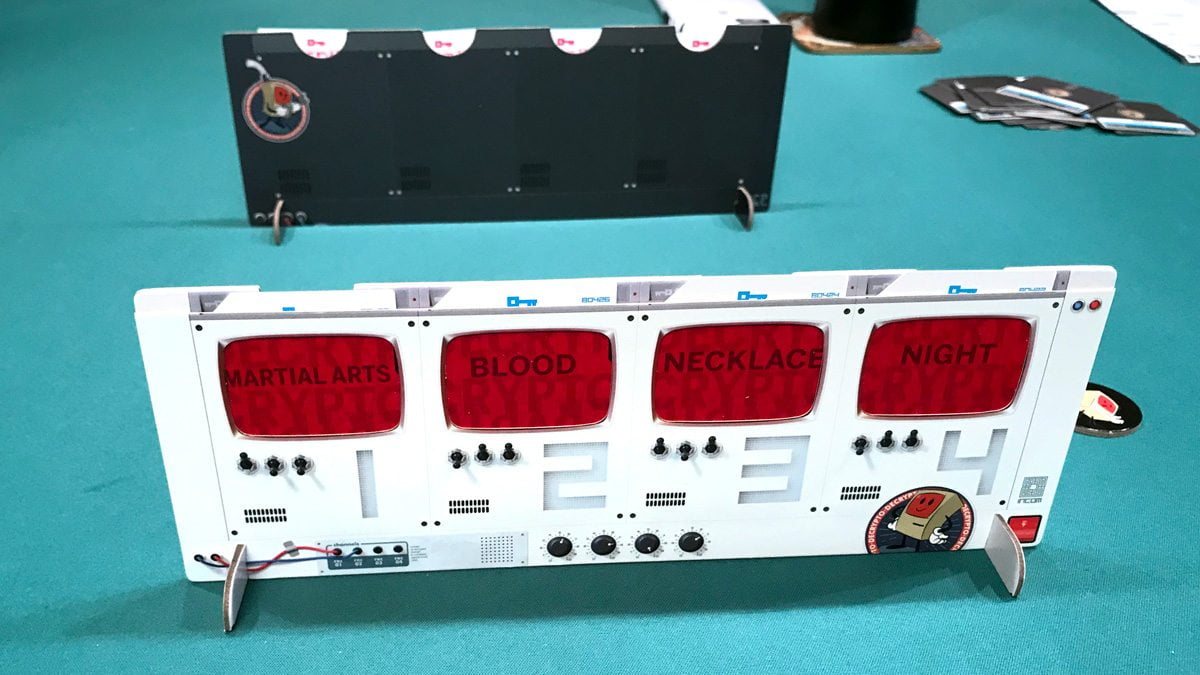
How to Play Decrypto
You can download a copy of the rules here.
The Goal
The goal of the game is to be the first to intercept two of the opposing team’s messages, while avoiding miscommunication on your own team.
Setup
Divide the group into two teams, and give each team a screen, 4 keyword cards, a note sheet, and a set of code cards. The intercept tokens, miscommunication tokens, and sand timer are set in the center of the play area. Each team should put their keyword cards into their screen, and position it so that the team can see the keywords but the opposite team cannot.
Gameplay
Players will take turns serving as the Encryptor for their team, and each round the Encryptors will attempt to communicate a code to their teammates.
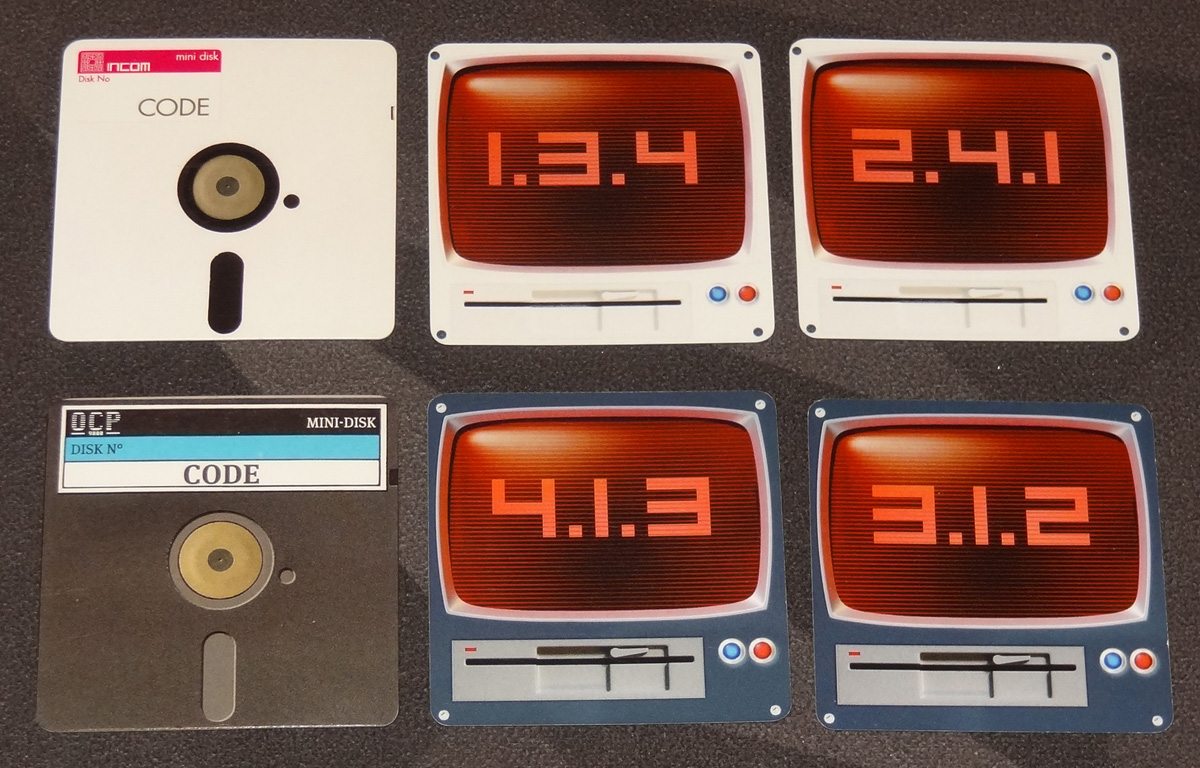
The Encryptor draws a code card from their own deck without showing it to anyone else. Each code card consists of three unique digits, like 3.1.2. The Encryptor gives three clues, one for each digit, in order, which both teams write down on their note sheets. (The note sheets are double-sided so that clues for the white team are written on the white side, and clues for the black team are written on the black side.)
The clues you give should refer to your team’s keywords, and there are some restrictions on the types of clues you’re allowed to give. For instance, clues should refer to the meaning of the keywords, not the spelling or number of letters, or pronunciation. The clues should also be public information–they can be obscure, like the name of a minor character from an old movie, but not private, like what you had for lunch. And, of course, you can’t use any of your keywords (or the code card) as clues. Clues can be any length and form: single words, entire sentences, or even humming a song or acting out a charade.
The sand timer is optional: after a team has finished writing their clues, they turn over the sand timer. The other team only has that much time to finish giving their clues, or else their team will have to make guesses with incomplete clues.
After both Encryptors have given their clues, the teams then get to discuss and guess the codes. In the first round, you will just guess your own code. Write down your three-digit guess in the first column, and then the Encryptor reveals the card to everyone. If you’re wrong, you get a miscommunication token. If you’re right, nothing else happens.
Starting from the second round, each team will try to guess both codes. Both teams will announce their guesses before the Encryptor reveals their codes. If you guess the other team’s code correctly, you get an interception token.

Since the keyword cards stay the same throughout the entire game, as the opposing team continues to give clues and you see what numbers they refer to, you may be able to piece together what their keywords are in order to intercept the messages. For instance, if the clues “bed,” “sleep,” and “moon” have all turned out to represent “4,” then when the clue “night” is given, you would probably guess it also represents “4.”
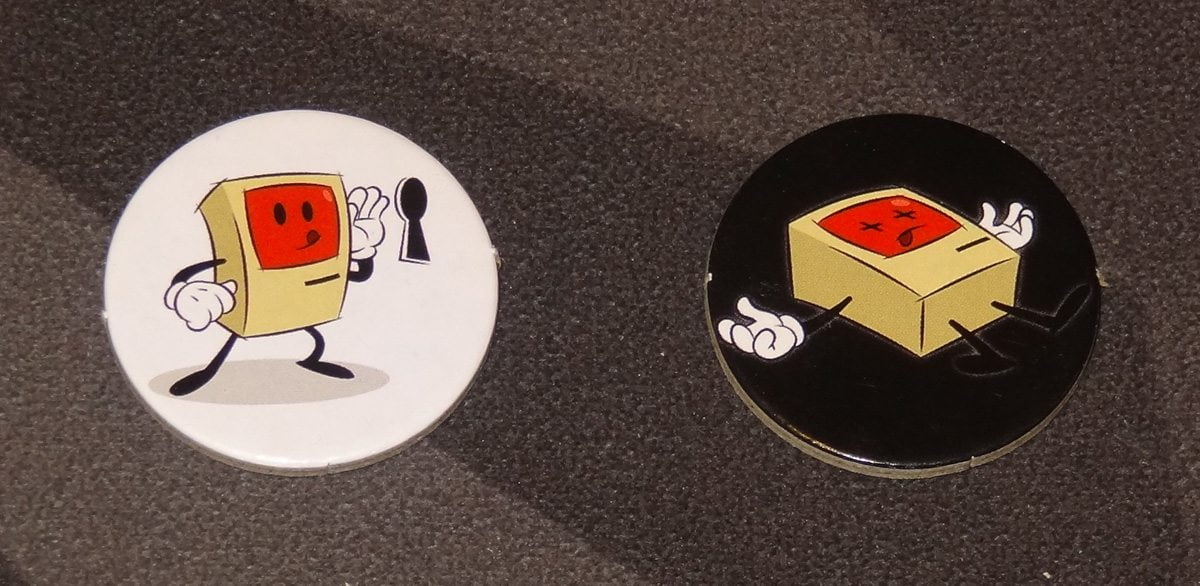
Game End
The game ends if either team gets two intercept tokens (they win) or two miscommunication tokens (they lose). There are various tiebreaker scenarios: for instance, if both teams reach two intercept or two miscommunication tokens in the same round, or if a team reaches two of each token in the same round, or if neither team has won by the end of the eighth round. Each intercept token is worth 1 point, and each miscommunication token is worth -1 point. Add up scores, and the higher score wins.
If there’s still a tie, each team tries to guess the opposing team’s keywords. Whoever guesses the most keywords wins.
3-Player Variant
In a 3-player game, two of the players are on a team and they try to communicate codes to each other. The third player only tries to intercept. If the 2-player team does not guess correctly, instead of getting a miscommunication token, they give the third player an interception token. The Interceptor wins by getting two tokens before the end of the 5th round; otherwise, the encrypting team wins.
Why You Should Play Decrypto
If your gaming group like games about clues and deduction (with a dash of spycraft for theme), then you’ll probably like Decrypto. I love the aesthetic of floppy disks and the red-filter screens, but it’s the gameplay that really shines.
At first blush, Decrypto seems like it has some similarities to Codenames or, well, any word-based guessing game going as far back as Taboo: you have some words and you’re trying to use other words to get your teammates to guess them in a particular order. In this case, however, there are fewer restrictions on what sorts of clues you can give, because the bigger issue is whether you can clue in your teammates without clueing in your opponents at the same time. As with games like Dixit, the key is finding the balance between too vague and too obvious.

For instance, in the image above, the keywords are Bread, Love, Triangle, and Volcano. If I use the word “lava,” I can be pretty sure that my team will guess #4: Volcano—and now the other team knows that “lava” goes with #4. On the next round, if my teammate uses “erupt” as a clue for #4, the other team is very likely to put those two clues together, and they’ll intercept that part of the code easily. What sort of clue could you give that would not easily be tied to “lava”?
The easier it is to decipher the pattern in your clues, the more quickly your rivals will intercept your codes. Giving more obscure clues increases the risk of miscommunication, though. If I give the clue “Joe,” will my team know that it’s a reference to Joe vs. the Volcano, or will they try to link it to Bread, Love, or Triangle instead?
Most of the times I’ve taught Decrypto, it doesn’t last many rounds the first time through, because it doesn’t take long for somebody to crack the other team’s codes. The clues simply have too much overlap. By the second game, though, players understand the need to be a little more careful with their messages, giving clues that are intentionally misleading if you don’t know the keywords connecting them. In Codenames, you’re trying to tie as many words as possible together with one clue. In Decrypto, it’s almost the reverse: you’re trying to give several clues that all link to the same word, without giving away what that word is.
It’s definitely a game that rewards repeat plays: as the players get a little more experience, they get better at understanding what types of clues to give. I still haven’t had a game last the full 8 rounds yet, but we’ve definitely improved. Another aspect that I really enjoy is that players take turns giving clues—and even the Encryptor gets to work with the team on guessing the other team’s clues, so you don’t feel entirely left out for a turn while your team discusses your clues.
I really enjoy Decrypto for the way it gets people thinking about wordplay and secret messages. It’s a little more complicated to teach than Codenames, but is definitely worth the effort. If you’re looking for another clue/deduction game for your gaming group, be sure to intercept a copy of Decrypto!
Click here to see all our tabletop game reviews.
If you’d like to stay up-to-date with all of our tabletop gaming coverage, please copy this link and add it to your RSS reader.
Disclosure: GeekDad received a copy of this game for review purposes.
